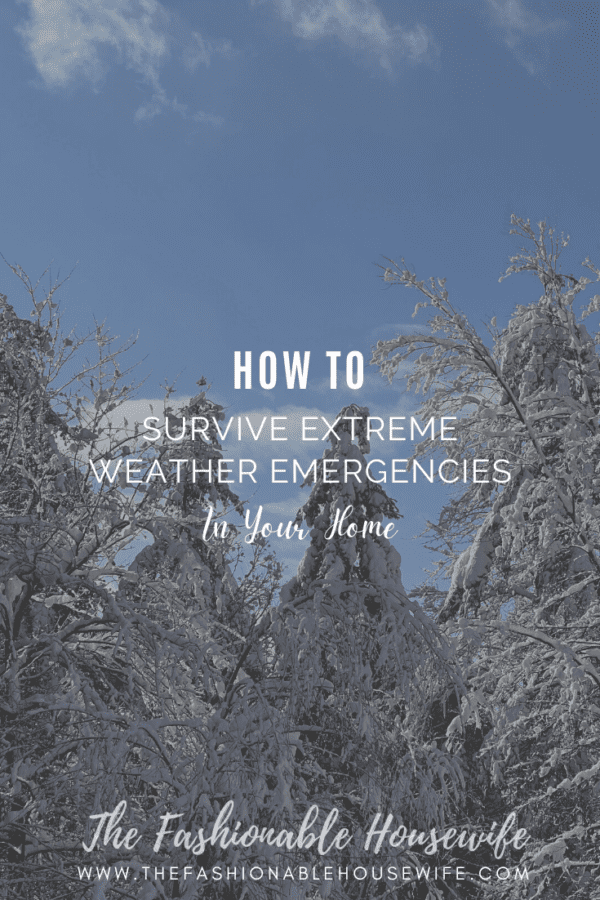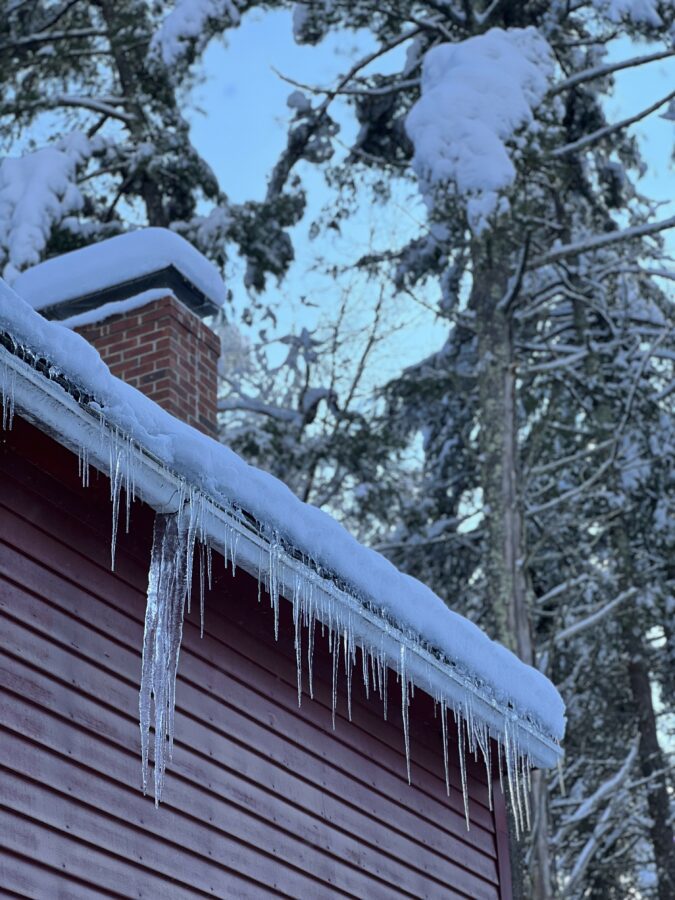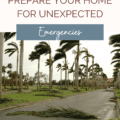
?
Extreme weather emergencies can be scary and dangerous. From hurricanes to tornadoes, they can cause severe damage to your home and put your safety at risk. In 2021 alone, the US had over 20 weather-related emergencies that cost the economy over $1 billion each to correct. While you can’t do anything about the different weather in your region, you can know how best to prepare to keep your family and property as safe as possible.
In this article, we’ll discuss what types of extreme weather emergencies you should be aware of, how to prepare your home for a weather emergency, what supplies you should have on hand, how to stay safe in your home during an emergency, how to help your neighbors during a weather emergency, and what to do after the storm.
Introduction
With climate change being a hot topic, the world is seeing an overall change in weather conditions whether they experience extreme weather or not. For example, the UK is seeing more cases of flooding than ever before and records show it is 7% wetter than it used to be, and sea levels have risen by 1.6 cm in recent years. Back in the US, the 13 natural disasters in 2021 costing in surplus of $1 billion are a sharp rise from the 3 events in the 1980s, indicating that the world and the US, in particular, are experiencing more and more weather-related disasters than at any other time in history.
Types of Extreme Weather Emergencies
Before we get into how to prepare for an extreme weather emergency, it is essential to understand the different types of severe weather emergencies. You may experience different types of extreme weather depending on where you live. In the United States, some of the most common weather-related emergencies include:
- Hurricanes: These storms can cause severe destruction with high winds, heavy rains, and flooding.
- Tornadoes: These storms can cause extreme damage with high winds and are especially dangerous in the Midwest and South.
- Flooding: Flooding can occur quickly due to heavy rains or overflowing rivers, and it can cause significant damage to homes and businesses.
- Wildfires: Wildfires can spread quickly and can destroy homes and property.
- Blizzards: Blizzards can cause severe winter weather with high winds, heavy snow, and frigid temperatures.
- Ice Storms: Ice storms can cause insane amounts of damage really quickly by rain freezing to trees and branches, quickly weighing down the branches causing them to break and fall off which takes out power lines, damages homes, closes roads, and more.
It is essential to be aware of the types of extreme weather in your area and be prepared for them.

Preparation Before the Storm
Once you know the types of extreme weather that can occur in your area, preparing for the storm before it happens is essential. There are several steps you can take to protect your home and family in the event of an extreme weather emergency.
- First, you should ensure that all windows and doors are properly sealed. This will help to protect your home from wind and water damage. You should also trim any trees and bushes around your home to reduce the chance of branches or debris falling onto your home during a storm.
- You should also check your roof for any loose shingles or other damage. If you find any, you should repair them immediately to prevent further damage during a storm.
- Additionally, you should clear any gutters and drains to ensure that water can flow away from your home.
- Make sure to move anything that can cause damage to your property secured away, e.g., garden furniture and outdoor toys and accessories.
- Ensure your pool is clear – it might not need to be covered, as the cover can cause additional damage.
- Finally, you should create an emergency plan for your family. This should include a list of emergency contacts, an evacuation plan, and a list of items to take with you if you have to evacuate.
You should also have an emergency kit ready to go. Make sure to include items like flashlights, batteries, a first aid kit, food, water, and other supplies you might need in an emergency. It’s also a good idea to have a generator on hand so you can have power even if it goes out.
It’s also essential to stay informed about the weather. Keep an eye on local news and weather reports, so you know what to expect and when to expect it. Access to a weather radio can also help you stay informed during an emergency.
How to Protect Your Home During Extreme Weather
Once you have prepared your home, you should take additional steps to protect it during an extreme weather emergency. This includes boarding up windows, using sandbags to reduce flooding, and securing any outdoor furniture or other items that could be blown away by strong winds. Do not tape your windows; it is a myth that it helps to secure them and is information that can cause additional damage and get people if they believe this helps.
It would help if you also unplug all electronics in your home to prevent them from being damaged by a power surge and ensure they are moved away from any way they can be water damaged. It can also be a good idea to fill your bathtubs and other containers with extra water in case your water supply is cut off during the storm.
Other tips include;
- Securing any valuables in waterproof containers or a safe place. This will help to protect them from damage during the storm.
- Cover clothes in bags or hard suitcases to avoid them becoming damaged or wet during storms.
- Securing loose fittings or removing removable rugs, flooring, and anything that can be damaged if you’re expecting a flood.
What Supplies to Have on Hand
In addition to preparing your home and protecting it during a storm, you should also have a few emergency supplies. This includes a first-aid kit, flashlights, extra batteries (including a fully charged power bank for your mobile phones, devices, and chargers), blankets, and non-perishable food and water. You should also have a battery-powered radio, a whistle, an emergency contact list, and a generator.
If you have children, you should have supplies such as diapers, formula, and other items you may need. The same goes for any pets you have; you should have extra food, water, and a carrier to transport them if you need to evacuate. You should also have a list of emergency shelters or hotels accepting pets.
How to Stay Safe in Your Home During an Emergency
Once you have prepared your home and gathered your supplies, you must know how to stay safe during an extreme weather emergency. This includes staying away from windows and doors, avoiding contact with floodwaters, and staying in a safe place away from any flying debris.
- If you are in an area prone to tornadoes, you should go to the lowest level of your home or a basement and cover yourself with blankets or mattresses for protection.
- If you are in a hurricane or flood zone, you should stay in an interior room away from any windows.
- If there is a power outage, you should stay in a well-ventilated room and use flashlights instead of candles. Additionally, you should avoid using any electronics, such as cell phones, laptops, or TVs.
If you’re told to evacuate, follow the instructions and leave immediately. If you’re told to take shelter, stay safe and away from windows and doors. Stay away from any flooded areas and stay away from power lines.
How to Help Your Neighbors During a Weather Emergency
In addition to protecting your own home, you should also help your neighbors during an extreme weather emergency. This includes checking on elderly or disabled neighbors who may need assistance. There are many ways you can help, from securing their property for them if they are unable, helping them to evacuate, or ensuring they have a stockpile of everything they need if they can remain at home, much like you would do for your family and sharing your resources if you can. Sometimes, allowing them to pass the time with others can ensure their safety and provide them with support and company during a stressful event.

What to Do After the Storm
Once the storm has passed, there are a few steps you should take to ensure that your home is safe and secure. This includes inspecting your home for any damage and making any necessary repairs. You should also check for downed power lines or other hazards and contact your local utility company for assistance.
Whether you need water damage restoration services, a complete rebuild of your property, or just a deep clean and tidy-up, getting started as soon as it is safe can help you get your life back together and support those around you who need help. Take pictures of all the damage so you have records for your insurance company or local government if they are providing assistance or you need help with what to do next. You then need to start the process of rebuilding your life after the danger has passed if severe damage has been caused.
Conclusion
Extreme weather emergencies can be dangerous and destructive, but with the proper preparation and knowledge, you can protect your home and keep yourself and your family safe. By understanding the types of extreme weather in your area, preparing your home before a storm, protecting your home during a storm, having the right supplies on hand, staying safe during an emergency, and helping your neighbors during a storm, you will be well prepared for any extreme weather emergency.




